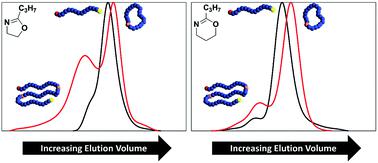当前位置:
X-MOL 学术
›
Polym. Chem.
›
论文详情
Our official English website, www.x-mol.net, welcomes your feedback! (Note: you will need to create a separate account there.)
Macrocyclization efficiency for poly(2-oxazoline)s and poly(2-oxazine)s
Polymer Chemistry ( IF 4.6 ) Pub Date : 2022-06-09 , DOI: 10.1039/d2py00376g Nick Huettner 1, 2 , Anja S. Goldmann 1, 2 , Richard Hoogenboom 3 , Tim R. Dargaville 1, 2
Polymer Chemistry ( IF 4.6 ) Pub Date : 2022-06-09 , DOI: 10.1039/d2py00376g Nick Huettner 1, 2 , Anja S. Goldmann 1, 2 , Richard Hoogenboom 3 , Tim R. Dargaville 1, 2
Affiliation

|
The unique material properties of cyclic polymers have made them attractive biomaterials, prompting the need for more efficient cyclization protocols. Due to their chemical versatility, poly(2-alkyl-2-oxazoline)s (PAOx) and poly(2-oxazine)s (POzi) provide potent candidates in this field. However, little to no comprehensive data on the cyclization process of these materials is available, especially not for POzi. In this study, we investigate the impact of a number of reaction parameters (batch volume, catalyst equivalents, molecular weight, and polymer addition method) on the macrocyclization efficiency of PAOx and POzi using copper(I)-catalysed azide–alkyne cycloaddition (CuAAC). It was found that POzi show more efficient conversion to the desired monocyclic species compared to PAOx, possibly due to increased chain flexibility of POzi. Considering macrocyclization efficiency, up to 33× more cyclic POzi could be synthesized per unit volume of solvent, compared to previous protocols for related PAOx, indicating potential for the future scale-up of macrocyclic POzi.
中文翻译:

聚(2-恶唑啉)和聚(2-恶嗪)的大环化效率
环状聚合物独特的材料特性使其成为有吸引力的生物材料,促使人们需要更有效的环化方案。由于它们的化学多功能性,聚 (2-烷基-2-恶唑啉) (PAOx) 和聚 (2-恶嗪) (POzi) 在该领域提供了强有力的候选者。然而,几乎没有关于这些材料的环化过程的全面数据,尤其是对于 POzi 而言。在这项研究中,我们研究了许多反应参数(批量、催化剂当量、分子量和聚合物添加方法)对使用铜的 PAOx 和 POzi 大环化效率的影响(I)-催化的叠氮化物-炔烃环加成 (CuAAC)。发现与 PAOx 相比,POzi 显示出更有效的转化为所需的单环物质,这可能是由于 POzi 的链柔韧性增加。考虑到大环化效率,与以前的相关 PAOx 协议相比,每单位体积的溶剂可以合成多达 33 倍的环状 POzi,这表明未来大环 POzi 的放大潜力。
更新日期:2022-06-14
中文翻译:

聚(2-恶唑啉)和聚(2-恶嗪)的大环化效率
环状聚合物独特的材料特性使其成为有吸引力的生物材料,促使人们需要更有效的环化方案。由于它们的化学多功能性,聚 (2-烷基-2-恶唑啉) (PAOx) 和聚 (2-恶嗪) (POzi) 在该领域提供了强有力的候选者。然而,几乎没有关于这些材料的环化过程的全面数据,尤其是对于 POzi 而言。在这项研究中,我们研究了许多反应参数(批量、催化剂当量、分子量和聚合物添加方法)对使用铜的 PAOx 和 POzi 大环化效率的影响(I)-催化的叠氮化物-炔烃环加成 (CuAAC)。发现与 PAOx 相比,POzi 显示出更有效的转化为所需的单环物质,这可能是由于 POzi 的链柔韧性增加。考虑到大环化效率,与以前的相关 PAOx 协议相比,每单位体积的溶剂可以合成多达 33 倍的环状 POzi,这表明未来大环 POzi 的放大潜力。



























 京公网安备 11010802027423号
京公网安备 11010802027423号